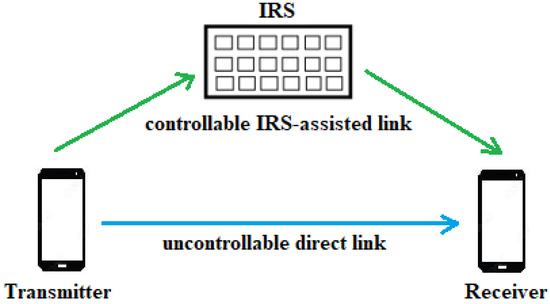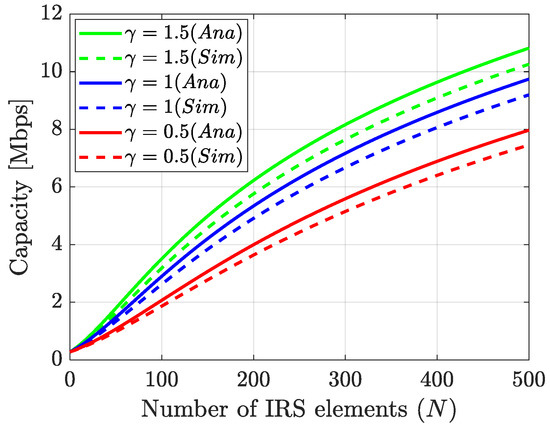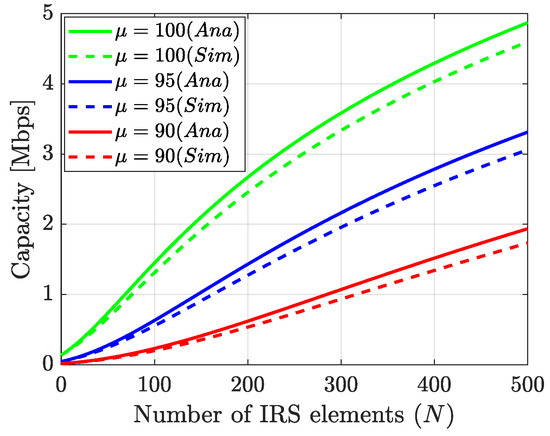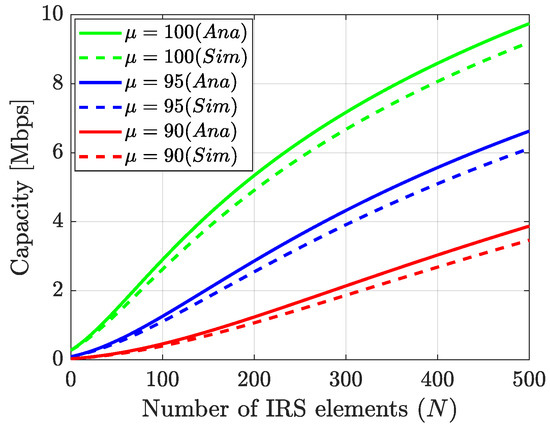Abstract
Future wireless networks are characterized as having a combination of various technologies such as artificial intelligence, machine learning, combined communication, sensing and others. In this context, intelligent reflecting surfaces have been identified as a powerful candidate for 6G enabling technologies. In this paper, we present the performance analysis of an intelligent reflecting surface (IRS)-assisted narrowband single-input single-output (SISO) system. We evaluate the capacity and received signal-to-noise ratio (SNR) of a SISO wireless system by considering the effect of amplitude response of the channel and changes in transmit SNR. The simulation results show that the capacity of the system can be significantly improved in the presence of passive, as well as active, reflecting elements even when the strength of the direct link between the transmitter and receiver is very low. Similarly, transmit SNR has a significant impact on the overall performance improvement of the system.
1. Introduction
With the global expansion of 5G networks, researchers have been focusing on the future of wireless networks that would be able to provide more promising high-end applications and much more reliable communications. These requirements call for sophisticated mechanisms to ensure uninterrupted communications. In this regard, 6G enabling technologies have been widely explored to provide fully automated and intelligent systems along with higher throughput, low latency, more reliability and better energy consumption [1]. Holographic radio, terahertz (THz) communications, intelligent reflecting surfaces (IRSs) and AI-based techniques for network management have been identified as some of the main drivers of 6G technology [2].
An IRS is an array of passive reflecting elements that provide control over propagation channel by altering the properties of waves incident upon it [3]. A promising aspect of controlling the radio propagation environment using an IRS is that it cannot only support the transmitted signal but also cancel out the unwanted signals, hence providing interference cancellation [4]. Therefore, several efforts have been made to analyze the behavior of a wireless communication system in the presence of a controllable IRS-assisted wireless link and significant performance improvements have been observed in different scenarios [5,6,7,8].
In this paper, we present the results of capacity analysis of an IRS-enabled SISO system based on the variations in the amplitude response of a narrowband wireless channel. As the characteristics of the IRS changes the properties, and hence, the impulse response of the channel, we see significant improvement in the overall capacity of an IRS-assisted system. Further, the increasing number of IRS elements also increases the capacity of the system.
The rest of the paper is organized as follows. Section 2 provides a brief account of the IRS-assisted radio environment by providing a brief review of the existing literature. Section 3 presents the description of the system model used in this study and the analytical expressions for the capacity of a narrowband channel in an IRS-assisted SISO system. The simulation results are presented in Section 4 along with relevant discussion. Section 5 concludes the paper.
2. IRS-Assisted Radio Environment
The ability of an IRS to modify the incident signals without the need for RF chains opens doors for the realization of diverse possibilities in a cost-effective manner. The modification of signals is performed by controlling the impedance of individual IRS elements which, in turn, control the amplitude and phase of the signal reflected by an IRS. An IRS reflection coefficient matrix is used to define the properties of reflected wave, and hence, it is able to program the radio environment [9].
In the perspective of IRS-assisted wireless propagation, two types of phase shift models have been investigated in the literature, which can be classified as the ideal phase shift model and the practical phase shift model. The ideal phase shift model assumes perfect IRS elements that only cause changes in phase without affecting the amplitude of the incoming wave. On the contrary, the practical phase shift model also considers the dependence of amplitude on the phase shift of each IRS element. In [10], the authors propose a practical phase shift model for an IRS-assisted multiple-input single-output (MISO) system that outperforms a conventional wireless system. In [11], the authors have jointly designed the beamforming at the access point (AP) and the phase vector of the reflecting surface by considering both perfect and imperfect channel state information (CSI). Performance analyses of an IRS-assisted MISO system have been presented in [12] by incorporating the joint effects of channel aging and channel estimation errors. The performance comparison of a decode and forward (DF) relay with an IRS-assisted multiuser MISO system in terms of achievable rate, transmit power and energy efficiency has been presented in [13], which unveils that an IRS-assisted system performs better with high quality-of-service (QoS) requirements as compared to a DF relay system.
The capacity region of an IRS-assisted system has been investigated in [14] under centralized and distributed arrangement of IRSs. In [15], the authors have proposed an IRS deployment scheme where an IRS is located near the base station (BS). In this way, an IRS is able to assist the base station in achieving noticeable coverage and performance gain as compared to the persistently explored user-side IRS deployment. Different use cases related to the integration of an IRS with existing systems and associated challenges are presented in our previous work [16].
Generally, IRSs are implemented as arrays of passive reflecting elements (REs) with passive loads which do not need external power source to reradiate the electromagnetic signals impinging upon them if they have predetermined reflection coefficients. An IRS can be made active by implementing some active REs in the arrays that are supported by active loads. Active IRSs have the ability to amplify the incident signal when reradiating it towards the desired direction [17]. The signal amplification provided by active IRSs makes the compact implementation possible as compared to the large array sizes required by passive IRS implementation [18]. The amplitude response of an IRS may be controlled by designing the active components so that they have a variable gain or attenuation. For this purpose, the phase and amplitude of the reflected waves may be adjusted by controlling the load impedance of the active REs, which affects the overall amplitude response of the IRS. This allows the IRS to amplify or attenuate the reflected waves depending upon the desired signal strength considering the level of interference or noise in the propagation environment. Another way to control the amplitude response of an IRS is to use a feedback loop that measures the amplitude of the reflected waves and to adjust the bias voltage or current of the active components accordingly. Therefore, the ability to control the amplitude response of an IRS plays a vital role in optimizing its performance in wireless communication systems, where the signal strength is highly inconsistent due to distance, obstacles and interference. In this context, we analyze the impact of passive and active IRS elements on the system capacity by increasing the amplitude response, assuming that it is independent of phase.
The literature review presented in this section gives a brief overview of currently investigated IRS-assisted wireless communication systems that may be used to achieve smart radio propagation environment for future wireless networks.
3. Capacity of an IRS-Enabled SISO System
The random nature of the wireless propagation environment makes it challenging to attain maximum advantage of the available bandwidth. However, the ability of IRS-assisted communication systems to reconfigure the properties of the signal makes it possible to achieve better performance with comparably low-cost implementation.
We consider a single antenna transmitter that communicates with a single antenna receiver over a narrowband AWGN channel. An IRS consisting of N elements is located between the transmitter and receiver as shown in Figure 1. The transmitted signal may reach the intended receiver through two possible paths, which are directly from the transmitter to the receiver, i.e., the transmitter–receiver path, or indirectly after being reflected from the IRS, i.e., the transmitter–IRS–receiver path. The direct transmitter–receiver path is uncontrollable, whereas the transmitter–IRS–receiver path is controllable due to the presence of reflecting elements between the transmitter and the receiver.

Figure 1.
Depiction of system model used in this study.
The IRS-assisted path can be controlled by adjusting the reflection coefficient matrix defined in Equation (3) such that all the signals incident upon the IRS reach the receiver at the same time. The capacity of this AWGN system is given by
where B is the channel bandwidth and SNR is the signal-to-noise ratio at the receiver.
For an IRS-assisted narrowband SISO system, SNR is calculated in [19] (Equation (2)).
where P is the transmit power; No is the noise power; ρ is the propagation loss of the uncontrollable direct link; αn is the propagation loss from the transmitter to the IRS; βn is the propagation loss from the IRS to the receiver; and Ø is the reflection coefficient matrix of the IRS elements, which is defined as follows:
where each is a product of an amplitude coefficient and a phase shift ∈ [0, 2π].
An IRS can be configured in three ways, namely, on-off IRS, phase shift IRS and phase and amplitude-controlled IRS. In case of an on-off IRS, individual IRS elements act as a switch. When the switch is on, the signal is reflected, and when the switch is off, the signal passes through the IRS without reflection. This configuration does not need any phase shift to be introduced to the incident wave, and hence, it is called ideal configuration. Phase shift IRS configuration takes into account the phase shift that is to be introduced to the incident wave so that the incident wave may be focused on the desired direction or the coherent waves may be combined at the receiver. The ability to control amplitude response of an IRS is also an attractive feature in terms of an increase in the signal strength. Phase shift and amplitude-controlled IRS configuration deals with both the phase and the amplitude at the same time. This configuration allows for active control over the amplitude response of the reflected wave along with introducing a desired phase shift to the wave. The reflection coefficient matrix defines the properties of IRS elements in terms of amplitude and phase shift in individual elements.
We consider the ideal configuration for obtaining system capacity represented in Equation (1). For simulation purposes, we assume a phase shift IRS configuration where each IRS reflection coefficient has a random phase independently and uniformly distributed in [0, 2π]. Further, we assume that the amplitude response is independent of phase shift and analyze the impact of amplitude response on the capacity of the IRS-assisted system described above. We analyze the system performance under these configurations and present the results in Section 4.
4. Simulation Results
This section presents the simulation results to analyze the performance of IRS-assisted systems in the presence of a weak uncontrollable path. A general formula for finding the path loss of IRS-assisted wireless communication systems was derived from [20] (Equation (3)). Since the transmitter and the receiver are fixed in the IRS-assisted SISO system represented in Figure 1, we can define αn = α and βn = β for all N. The analytical results for (1) have been generated assuming ideal IRS configuration with α = −80 dB, β = −60 dB and ρ = −110 dB, which shows a weak direct link. We define transmit SNR as µ = P/BNo = 100 dB. The results have been generated by averaging 10,000 realizations of the Monte Carlo simulation. We assume different values of amplitude response that give insight into the impact of amplitude response on the capacity of the system.
Figure 2 shows the performance of the system in terms of system capacity with N approaching 500, B = 1 MHz and a weak direct link, i.e., ρ = −110 dB. Firstly, the analytical and simulation results were generated by assuming γ = 1.5, which means that the IRS has active REs providing signal amplification; then, both results are shown for the other 2 values of γ, which are 1 and 0.5, respectively.

Figure 2.
Capacity of IRS-assisted narrowband system with different values of amplitude response and B = 1 MHz.
It can be observed that when γ = 1.5, the simulation results approach the analytical results even with 100 elements and the system is able to achieve higher capacity as compared to lower values of γ. When γ = 1, which means a perfect reflecting IRS, about 10% decrease in capacity is observed as compared to the higher value of γ. It is clear from the figure that when γ < 1, there is an obvious 30% decline in the system capacity.
The performance of the system with N approaching 500 and B = 2 MHz is analyzed in Figure 3. Figure 3 shows that an increase in bandwidth by 1 MHz along with γ = 1.5 doubles the system capacity. At γ = 0.5 and B = 2 MHz, the system gives double the performance in terms of capacity as compared to the performance at B = 1 MHz, which means that a passive IRS performs well in a few MHz bands along with a weak uncontrollable direct link.

Figure 3.
Capacity of IRS-assisted narrowband system with different values of amplitude response and B = 2 MHz.
The impact of amplitude response on the system and the capability of the IRS to achieve sufficient capacity in the presence of a weak direct path is obvious from Figure 2 and Figure 3.
Transmit SNR is another constraint that needs to be optimized in order to attain the maximum potential of a wireless communication system. The impact of change in transmit SNR ‘µ’ is analyzed in Figure 4 and Figure 5 with up to five hundred IRS elements. It may be observed in Figure 4 that a 5 dB decrease in µ halves the system capacity even with 500 IRS elements. At µ = 95 dB and 90 dB, a drastic difference and decrease in capacity may be observed.

Figure 4.
Capacity of IRS-assisted narrowband system with different values of transmit SNR, γ = 1 and B = 1 MHz.

Figure 5.
Capacity of IRS-assisted narrowband system with different values of transmit SNR, γ = 1 and B = 2 MHz.
Figure 5 shows the effect of change in transmit SNR with γ = 1 and B = 2 MHz. It is observed that for µ = 100 dB, the simulation results approach the analytical results. When µ is decreased, there is an evident decrease in the system capacity, but it is about 50% higher than the capacity achieved with 1 MHz bandwidth.
Further, there is a tradeoff between amplitude response and transmit SNR. This tradeoff is evident from Figure 3 and Figure 5. In Figure 3, with γ = 1.5 and B = 2 MHz, the system capacity is 10 Mbps, whereas in Figure 5, the system capacity is 9 Mbps with γ = 1, which means that no amplification was provided by the IRS elements. However, the performance difference in terms of capacity is very small. Therefore, it can be concluded that in the case of a passive IRS, the transmit SNR also plays a vital role in achieving an optimized system performance.
5. Conclusions
In this paper, we have presented the effect of a change in amplitude response on the capacity of an IRS-assisted narrowband system. The simulation results show a significant improvement in the system capacity with increasing values of amplitude response. It has been observed that when the amplitude response is greater than one, the system may achieve comparable capacity with a smaller number of IRS elements, which in turn, can be utilized to decrease the IRS array size. The reduced array size allows for dense and feasible deployment of IRSs. The impact of varying transmit SNR was also observed. The results reveal that passive IRS implementation may perform equally well as an active IRS, provided that the transmit SNR is sufficiently high. These aspects make IRSs the most suitable choice for incorporating conventional wireless communication systems so that these systems may fulfill the data-hungry demands of emerging integrated networks.
Author Contributions
Conceptualization and formal analysis, A.D.; writing—original draft preparation, A.D.; writing—review and editing, N.F. All authors have read and agreed to the published version of the manuscript.
Funding
This research received no external funding.
Institutional Review Board Statement
Not applicable.
Informed Consent Statement
Not applicable.
Data Availability Statement
Data sharing not applicable.
Conflicts of Interest
The authors declare no conflict of interest.
References
- You, X.; Wang, C.X.; Huang, J.; Gao, X.; Zhang, Z.; Wang, M.; Huang, Y.; Zhang, C.; Jiang, Y.; Wang, J.; et al. Towards 6G wireless communication networks: Vision, enabling technologies, and new paradigm shifts. Sci. China Inf. Sci. 2021, 6, 110301. [Google Scholar] [CrossRef]
- Tataria, H.; Shafi, M.; Molisch, A.F.; Dohler, M.; Sjöland, H.; Tufvesson, F. 6G Wireless Systems: Vision, Requirements, Challenges, Insights, and Opportunities. Proc. IEEE 2021, 109, 1166–1199. [Google Scholar] [CrossRef]
- Gong, S.; Lu, X.; Hoang, D.T.; Niyato, D.; Shu, L.; Kim, D.I.; Liang, Y.-C. Toward Smart Wireless Communications via Intelligent Reflecting Surfaces: A Contemporary Survey. IEEE Commun. Surv. Tutor. 2020, 22, 2283–2314. [Google Scholar] [CrossRef]
- Jiang, T.; Yu, W. Interference Nulling Using Reconfigurable Intelligent Surface. IEEE J. Sel. Areas Commun. 2022, 40, 1392–1406. [Google Scholar] [CrossRef]
- Tao, Q.; Wang, J.; Zhong, C. Performance Analysis of Intelligent Reflecting Surface Aided Communication Systems. IEEE Commun. Lett. 2020, 24, 2464–2468. [Google Scholar] [CrossRef]
- Wu, Q.; Zhang, R. Intelligent Reflecting Surface Enhanced Wireless Network via Joint Active and Passive Beamforming. IEEE Trans. Wirel. Commun. 2019, 18, 5394–5409. [Google Scholar] [CrossRef]
- Xu, Y.; Qin, Z.; Zhao, Y.; Li, G.; Sari, G.G.H. Resource Allocation for Intelligent Reflecting Surface Enabled Heterogeneous Networks. TechRxiv 2020. [Google Scholar] [CrossRef]
- Hu, X.; Wang, J.; Zhong, C. Statistical CSI based design for intelligent reflecting surface assisted MISO systems. Sci. China Inf. Sci. 2020, 63, 222303. [Google Scholar] [CrossRef]
- Han, P.; Zhou, Z.; Wang, Z. Joint User Association and Passive Beamforming in Heterogeneous Networks With Reconfigurable Intelligent Surfaces. IEEE Commun. Lett. 2021, 25, 3041–3045. [Google Scholar] [CrossRef]
- Abeywickrama, S.; Zhang, R.; Yuen, C. Intelligent Reflecting Surface: Practical Phase Shift Model and Beamforming Optimization. IEEE Trans. Commun. 2020, 68, 5849–5863. [Google Scholar] [CrossRef]
- Guo, H.; Liang, Y.-C.; Chen, J.; Larsson, E.G. Weighted Sum-Rate Maximization for Reconfigurable Intelligent Surface Aided Wireless Networks. IEEE Trans. Wirel. Commun. 2020, 19, 3064–3076. [Google Scholar] [CrossRef]
- Zhang, Y.; Zhang, J.; Ng, D.W.K.; Xiao, H.; Ai, B. Performance analysis of reconfigurable intelligent surface assisted systems under channel aging. Intell. Converg. Netw. 2022, 3, 74–85. [Google Scholar] [CrossRef]
- Mustaghfirin, M.; Singh, K.; Biswas, S.; Huang, W.-J. Performance Analysis of Intelligent Reflecting Surface-Assisted Multi-Users Communication Networks. Electronics 2021, 10, 2084. [Google Scholar] [CrossRef]
- Zhang, S.; Zhang, R. Intelligent Reflecting Surface Aided Multi-User Communication: Capacity Region and Deployment Strategy. IEEE Trans. Commun. 2021, 69, 5790–5806. [Google Scholar] [CrossRef]
- Huang, Y.; Mei, W.; Zhang, R. Empowering Base Stations With Co-Site Intelligent Reflecting Surfaces: User Association, Channel Estimation and Reflection Optimization. IEEE Trans. Commun. 2022, 70, 4940–4955. [Google Scholar] [CrossRef]
- Danish, A.; Ali, S.; Aslam, M.I.; Ahmed, I. Future prospects and challenges associated with intelligent reflecting surfaces enabled wireless communication. In Proceedings of the 2021 IEEE 18th International Conference on Smart Communities: Improving Quality of Life Using ICT, IoT and AI (HONET), Karachi, Pakistan, 11–13 October 2021; IEEE: Piscatvey, NJ, USA, 2021; pp. 121–125. [Google Scholar] [CrossRef]
- Long, R.; Liang, Y.-C.; Pei, Y.; Larsson, E.G. Active Reconfigurable Intelligent Surface-Aided Wireless Communications. IEEE Trans. Wirel. Commun. 2021, 20, 4962–4975. [Google Scholar] [CrossRef]
- Long, R.; Liang, Y.-C.; Pei, Y.; Larsson, E.G. Active Intelligent Reflecting Surface for SIMO Communications. In Proceedings of the GLOBECOM 2020-2020 IEEE Global Communications Conference, Taipei, Taiwan, 7–11 December 2020; pp. 1–6. [Google Scholar] [CrossRef]
- Bjornson, E.; Wymeersch, H.; Matthiesen, B.; Popovski, P.; Sanguinetti, L.; de Carvalho, E. Reconfigurable Intelligent Surfaces: A signal processing perspective with wireless applications. IEEE Signal Process. Mag. 2022, 39, 135–158. [Google Scholar] [CrossRef]
- Tang, W.; Chen, M.Z.; Chen, X.; Dai, J.Y.; Han, Y.; Di Renzo, M.; Zeng, Y.; Jin, S.; Cheng, Q.; Cui, T.J. Wireless Communications With Reconfigurable Intelligent Surface: Path Loss Modeling and Experimental Measurement. IEEE Trans. Wirel. Commun. 2020, 20, 421–439. [Google Scholar] [CrossRef]
Disclaimer/Publisher’s Note: The statements, opinions and data contained in all publications are solely those of the individual author(s) and contributor(s) and not of MDPI and/or the editor(s). MDPI and/or the editor(s) disclaim responsibility for any injury to people or property resulting from any ideas, methods, instructions or products referred to in the content. |
© 2023 by the authors. Licensee MDPI, Basel, Switzerland. This article is an open access article distributed under the terms and conditions of the Creative Commons Attribution (CC BY) license (https://creativecommons.org/licenses/by/4.0/).